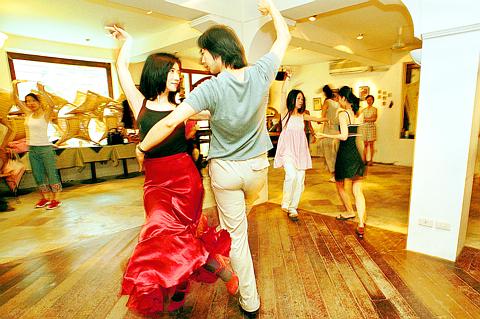Six years ago on a rainy day, painter Lee Shin (
"Each of your works is like a dance," he said to her.
"He told me he was a Flamenco dancer from an amateur troupe," she recalls.

PHOTO: CHEN CHENG-CHANG, TAIPEI TIMES
"That is a very profound dance," he said, exploring the gallery with her.
"I later realized he was the only dancer in the 'troupe'," she says. "But by the time I realized it, I'd already fell in love with the dance - the beauty and passion, the joy and sadness of Gypsy's lives."
Lee Shin and Lin Keng (

PHOTO: CHEN CHENG-CHANG, TAIPEI TIMESN
"This dance troupe was a result of playing too much and playing too far with my life," Lee says, jokingly.
A life left behind
Before "the dancer" Lee Shin, or even the painter Lee Shin, there was Lee Shin the dentist, employed at a public hospital for more than a decade. She was a career woman with an affluent income, the wife of a successful businessman and the mom of a 10-year-old girl. She was well-off and secure.
But security was never what she'd been looking for. "I wore white robes with mask, facing my patients everyday. But I felt out of touch with people and life," she says. "Of course you can find senses of achievement in curing people's illnesses, but ... teeth problems are, essentially, never solvable. You solve a problem and then there comes another. More and more you feel your life is repetition."
So Lee began her search for art, at the age of 35, by painting and then dancing. She soon gave up her million-dollar income, and eventually her status as a middle-class family hostess. In the end, she and her husband also separated.
"I began to appreciate men, not because of their wealth and status, or their potential for success," she recalls.
Intrigue and intimacy
It was the ethnic culture and the graceful feelings of Flamenco that charmed both Lee and Lin. From 1994, Lee and Lin began enthusiastically pursuing Flamenco, learning from videotapes, local teachers and foreign dancers.
As a full-time single mom, Lee had to make use of rare spare moments to learn the dance; for example, during the one-hour her daughter learned piano, or before the girl came home from school.
For many, Taiwan is rather sterile place to learn about Flamenco and the Gypsy arts. So Lin Keng, who is five years younger than Lee and teaches English at a junior college in Taipei, was usually busying surfing the Internet during his free time. He chatted and exchanged information with Flamenco fans around the world, mail-ordered CDs and tapes, and learned Spanish.
In 1995, Lee and Lin, Teresa Barja, a dancer, and guitarist Chan Che-hsiung (詹哲雄) began performing at a pub in Tienmu. Lin and Lee's obsession for Flamenco also lead them to make a pilgrimage to Spain two years ago, for a month of dancing lessons.
All this has led to a greater interest among locals in what they do. Nowadays, Fuego Fantastico has 20 members and Lin, being the leader, gives weekly performances at Taipei pubs. The troupe also gives weekly lessons at their hillside studio, with students ranging from housewives and writers to TV reporters.
During the five years of her dance odyssey, Lin has also kept up with her painting - hosting two other exhibitions. She has also ventured into writing, publishing Life as Tap Dancing (
"Throughout these years, I seem to have digressed from my original tracks. But I feel like I have in fact just stepped onto the right path of my life. There is no question of success. It is only about sweating, about craving, only about walking freely in the wilderness of the graceful sun and cool breeze," Lee wrote in her first book.
For Lee, her self-realization for art and her journey toward gaining female autonomy is just like her attraction to Flamenco dance, "especially women's role in the dance".
"Women in Flamenco are very strong and very tough. On the one hand they are sweet and feminine, but on the other hand their characters are full of energy," she says.
"In many Flamenco repertoires, women are expressing their struggle with their lives and environment. ... To me, this shows that women can be very powerful and fierce, but they can also be flirtatious and attractive when they want to."
For Lin Keng, too, the dance's condensed emotions also hold unique appeal to him. "The man can use his feet, taping like an instrument, to express his feelings and personalities. You don't have to do high kicks, or dancing acrobatics to show your masculinity. In Flamenco, men are extremely masculine. Simply by standing still, you can look very strong," he says.
Out on the floor
"One, two, one two three ... everybody watch me and teacher Lin!"
It's another dance class on a cruel summer afternoon. With her tiny voice, the slim Lee instructs 30 students at a local cafe. As she speaks, she raises her arms and flounces her skirt, sending it reeling and curling in hypnotic waves. Lin holds her, his arm enveloping her tiny waist as they whirl about, eyes locked on each other.
The students follow the steps, until they break down one by one, confused by the increasing intensity. Finally, everyone just watches the couple.
"They look very graceful! Oh, I cannot dance like that!" says one student. "Just watching them I can feel the Flamenco passion!" says another.
Many of them want to learn this dance because they have seen Lee's shows and read her books. The dance class attracts predominantly women and mostly elementary teachers.
Later this summer, Fuego Fantastico is opening another Flamenco class at Keng-hsin cultural center, sowing more seeds of old Spanish fervency into the fertile Taiwanese mind.
As late beginners of the art, Lee and Lin may not be Taiwan's best Flamenco dancers, but they are definitely among the most enthusiastic. "The mid-life crisis is two sided," Lee says. "It either makes people more conservative, more likely to shrink back, or it makes people more crazy about something."
"But for me, middle age is the best age because your body still works well, and you are economically more secure than younger days. So you should be more crazy."

“Why does Taiwan identity decline?”a group of researchers lead by University of Nevada political scientist Austin Wang (王宏恩) asked in a recent paper. After all, it is not difficult to explain the rise in Taiwanese identity after the early 1990s. But no model predicted its decline during the 2016-2018 period, they say. After testing various alternative explanations, Wang et al argue that the fall-off in Taiwanese identity during that period is related to voter hedging based on the performance of the Democratic Progressive Party (DPP). Since the DPP is perceived as the guardian of Taiwan identity, when it performs well,

The Taiwan People’s Party (TPP) on May 18 held a rally in Taichung to mark the anniversary of President William Lai’s (賴清德) inauguration on May 20. The title of the rally could be loosely translated to “May 18 recall fraudulent goods” (518退貨ㄌㄨㄚˋ!). Unlike in English, where the terms are the same, “recall” (退貨) in this context refers to product recalls due to damaged, defective or fraudulent merchandise, not the political recalls (罷免) currently dominating the headlines. I attended the rally to determine if the impression was correct that the TPP under party Chairman Huang Kuo-Chang (黃國昌) had little of a

At Computex 2025, Nvidia CEO Jensen Huang (黃仁勳) urged the government to subsidize AI. “All schools in Taiwan must integrate AI into their curricula,” he declared. A few months earlier, he said, “If I were a student today, I’d immediately start using tools like ChatGPT, Gemini Pro and Grok to learn, write and accelerate my thinking.” Huang sees the AI-bullet train leaving the station. And as one of its drivers, he’s worried about youth not getting on board — bad for their careers, and bad for his workforce. As a semiconductor supply-chain powerhouse and AI hub wannabe, Taiwan is seeing

Jade Mountain (玉山) — Taiwan’s highest peak — is the ultimate goal for those attempting a through-hike of the Mountains to Sea National Greenway (山海圳國家綠道), and that’s precisely where we’re headed in this final installment of a quartet of articles covering the Greenway. Picking up the trail at the Tsou tribal villages of Dabang and Tefuye, it’s worth stocking up on provisions before setting off, since — aside from the scant offerings available on the mountain’s Dongpu Lodge (東埔山莊) and Paiyun Lodge’s (排雲山莊) meal service — there’s nowhere to get food from here on out. TEFUYE HISTORIC TRAIL The journey recommences with